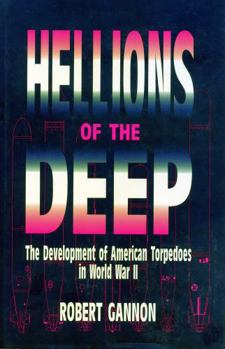Hellions of the Deep: The Development of American Torpedoes in World War II
Select Format
Select Condition 
Book Overview
Ultimately, World War II was the first war won by technology, but within only a few weeks after the war began, the U.S. Navy realized its torpedo program was a dismal failure. Submarine skippers reported that most of their torpedoes were either missing the targets or failing to explode if they did hit. The United States had to work fast if it expected to compete with the Japanese Long Lance, the biggest and fastest torpedo in the world, and Germany's...
Format:Hardcover
Language:English
ISBN:027101508X
ISBN13:9780271015088
Release Date:May 1996
Publisher:Penn State University Press
Length:256 Pages
Weight:1.42 lbs.
Dimensions:0.8" x 6.0" x 9.0"
Customer Reviews
5 ratings
FInally, a book on WWII torpedoes
Published by Thriftbooks.com User , 15 years ago
Anyone with an interest in WWII submarine stories and history has read tales of the multitude of problems with US WW II torpedoes. They ran too deep, the new magnetic exploders didn't work, and sometimes they would run in a circle and sink the submarine that fired the torpedo. Even the old WW I era contact exploders were troublesome. But it has been difficult to find out anymore about this subject until the publication of Hellions of the Deep. This book takes an detailed look at the development of US torpedoes, which are much more complicated devices than most people realize. The writing is a tad dry, and a few names of people who 'helped develop' (read hindered) the troublesome torpedoes are withheld, which is why I only gave it four stars. But overall, a valuable book to serious students of WW II naval history.
A complete account!
Published by Thriftbooks.com User , 17 years ago
This book is as complete a work on the development of USN torpedoes used in World War II as one is likely to find. The work covers the topic in a clear, easy to understand format delving in to the development of these weapons systems. It covers the technical developments without becoming so technical as to make the text difficult to read. This book will make any reader aware of this story and the tecnology/development of a weapons system that is often mentioned but rarel explained in any depth.
Excellent book regarding torpedo but with some flaws
Published by Thriftbooks.com User , 19 years ago
This book is an excellent reference source for anyone interested in the development of American torpedoes during WW2 and is highly recommended. The reason for the four star rating is because the work contains some minor errors and is unclear in some more important areas. OK first the minor errors. Page 68 describes hydrogen peroxide as "H2O2O". Funny when I received my degree hydrogen peroxide was H2O2. Next the line drawing on page 42 illustrates what is known as a "steam" type torpedo and yet the illustration is labelled with an electric motor as being the propulsion unit even though the illustration contains no batteries. It does show the air and fuel flasks of a "steam" type torpedo and the description accompanying the drawing is consistent with a "steam" type torpedo. Actually, although small, the drawing shows what appears to be a turbine and bevel gear unit- again consistent with a "steam" type torpedo engine- even if they are labelled as an electric motor. OK So much for the minor errors. I consider them unimportant as they in no way detract from the value of the book and any skilled reader can easily compensate. The problem comes on page 48 where the Japanese "Long Lance" type 93 torpedo is described as being driven by "liquid hydrogen peroxide". Although not a US torpedo this book is so authoritative and well written that all its disclosures clearly carry weight. Given the state of the art in the 1930's I would tend to believe that compressed pure oxygen gas was used in the type 93(ie not H2O2) and indeed a number of web pages support this view. (search for yourself to check this out). Unfortunately the author does not help matters as at page 135 he says "during the war the japanese skippers preferred the "oxygen" hydrogen peroxide torpedoes". Now although when hydrogen peroxide decomposes it does produce oxygen as well as high temperature steam it is a different chemical species to oxygen and within the naval world an "oxygen torpedo" is one that uses compressed O2 gas. A peroxide torpedo is a peroxide torpedo. I have been unable to track down the authors references for the peroxide Long Lance but from the book they do not appear to be primary sources. Given that the Japanese Long Lance had twice the speed and around five time the range of the best US torpedo and came as an almighty shock to the allies I would have preferred some more details from the author to support his views on the Long Lance.
A good companion book to "Silent Victory" by Clay Blair.
Published by Thriftbooks.com User , 24 years ago
Silent Victory contains a fair amount of data regarding the torpedo problems experienced by the U.S. Navy's Pacific Fleet Submarine Force during the Second World War. This book goes into considerably more detail regarding the background to those problems and their solutions--both bureaucratic and engineering--and how U.S. torpedo technology literally moved two generations ahead during wartime.
A great book about torpedo technology
Published by Thriftbooks.com User , 24 years ago
This is a magnificent book about the torpedo development in the US Navy. Mainly focused in the WWII period, the book details all the problems that plagued US torpedoes and the way they were solved. This is a great book. Every person interested in WW II naval technology, submarines or naval weaponry shall be delighted with it.






